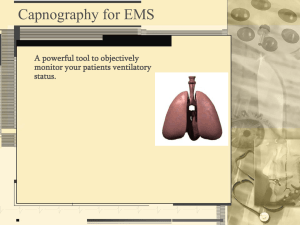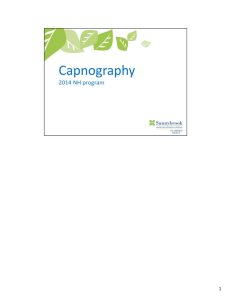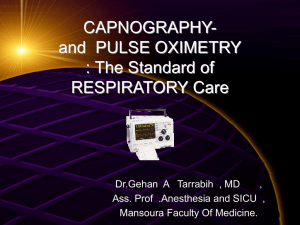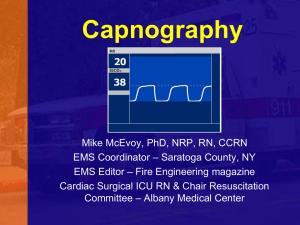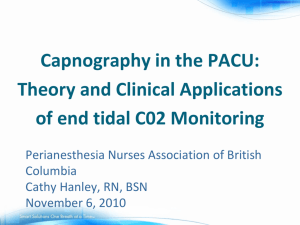Capnography in EMS - faculty at Chemeketa
advertisement
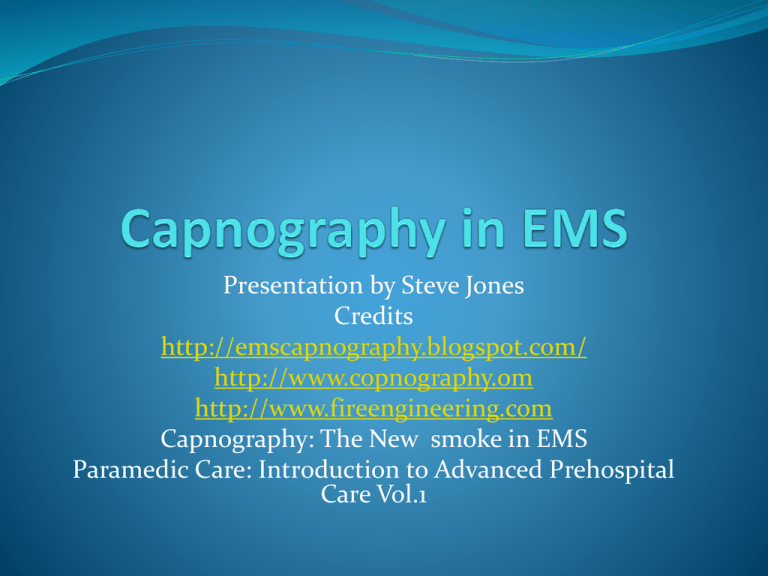
Presentation by Steve Jones Credits http://emscapnography.blogspot.com/ http://www.copnography.om http://www.fireengineering.com Capnography: The New smoke in EMS Paramedic Care: Introduction to Advanced Prehospital Care Vol.1 CASE 1 “Link Goes Down” Meet Link, an above average kind of guy, enjoying the life of retirement after his hit show the Mod Squad. Until… BAM! Link crashes to the floor right in front of his EMT friend, “hot dog” Paramedic Henry Jackson. Henry right away does his ABC’s, gets a monitor on ol’ Link and noticed his SpO2 was 99. Thinking that Link was ventilating okay, Henry decided to double check by putting the nasal cannula with the capnography device on Link to see what his PetCO2 was. Well this is what he saw…. Holy baby diapers! He saw an indication of a small amount of CO2 showing on the monitor. Link’s ETCO2 level was low. This meant that his PaCO2 was probably high. Quickly a BVM, with O2, was applied to assist Link with his breathing. But in all the excitement Henry started to Hyperventilate good Ol’ Link. Henry happened to look at to monitor again and saw… WOW! … a large amount of CO2 was showing on the monitor. Link was now exhaling too much CO2. Henry said to himself, “Slow down little doggie.” Well, Henry did eventually get it right, thanks to Capnography, and Ol’ Link ended up being back to his old self …. Happy! And once again enjoying life after his hit show, the Mod Squad. So what is capnography? “CO2 is the smoke from the flames of metabolism.”– Ray Fowler, M.D. Dallas, Street Doc’s Society Metabolism generating CO2 is like an automobile generating exhaust. Capnography is the tool that detects and measures the smoke. Definitions Capno (kapnos) – graphy (graphos) (Kapnos=smoke) (graphos=to write or record data) “To record the smoke” CC Capnography – the measurement of carbon dioxide (CO2) in exhaled breath. Capnometer – the numeric measurement of CO2. Capnogram – the wave form. End Tidal CO2 (ETCO2 or PetCO2) - the level of (partial pressure of) carbon dioxide released at end of expiration. Capnography: Ventilation vs. Oxygenation Oxygenation is how we get oxygen to the tissue. Oxygen is inhaled into the lungs where gas exchange occurs at the capillary-alveolar membrane. Oxygen is transported to the tissues through the blood stream. Pulse oximetry measures oxygenation. At the cellular level, oxygen and glucose combine to produce energy. Carbon dioxide, a waste product of this process (The Krebs cycle), diffuses into the blood. Ventilation (the movement of air) is how we get rid of carbon dioxide. Carbon dioxide is carried back through the blood and exhaled by the lungs through the alveoli. Capnography measures ventilation. Krebs Cycle CO2 Capnography versus Pulse Oximetry Capnography provides an immediate picture of patient condition. Pulse oximetry is delayed. Hold your breath. Capnography will show immediate apnea, while pulse oximetry will show a high saturation for several minutes. Circulation and Metabolism While capnography is a direct measurement of ventilation in the lungs, it also indirectly measures metabolism and circulation. For example, an increased metabolism will increase the production of carbon dioxide increasing the ETCO2. A decrease in cardiac output will lower the delivery of carbon dioxide to the lungs decreasing the ETCO2. “CO2 is the smoke from the flames of metabolism.”– Ray Fowler, M.D. Dallas, Street Doc’s Society ETCO2 in Asthma, COPD, and CHF End-tidal CO2 monitoring on non-intubated patients is an excellent way to assess the severity of Asthma/COPD, and the effectiveness of treatment. Bronchospasm will produce a characteristic “shark fin” wave form, as the patient has to struggle to exhale, creating a sloping “B-C” upstroke. The shape is caused by uneven alveolar emptying. Fig. 2 Multiple studies have confirmed the sloping shape correlates to bronchospasm and obstructive lung disease. Respiratory Assessment & Treatment “One issue for many paramedics, both experienced and new to the street, is lung sound auscultation and definition. Is that high-pitched sound wheezing, rales, something else? In one previous set of protocols, our respiratory treatment algorithm divided in part based on lung sounds. If the patients had wheezes, they received albuterol and epinephrine. If it was rales, they received nitroglycerin, lasix, and morphine. One comment heard often in the field is just to treat respiratory issues with albuterol. Although albuterol has several positives in the treatment of some respiratory diseases, it is certainly not a cure-all by any means. Its cardiac side effects should always be taken into consideration, and a patient whose respiratory condition is secondary to their cardiac problem could deteriorate from inappropriate albuterol administration. Lung sounds and dispatch information are not enough. Thorough assessment is required in any patient, but capnography can take us another step into the realm of definitive respiratory assessment and treatment by giving us another tool to better care for our patients.” Capnography: The New Smoke in EMS ETCO2 readings can also be used to assist in difficult intubations of spontaneously breathing patients. “Paramedics can attach the capnography filter to the ET tube prior to intubation and, in cases where it is difficult to visualize the chords, use the monitor to assist placement. This includes cases of nasal tracheal intubation.” You’re Out! (missed the cords) You’re In! Reason ETCO2 is zero: The tube is in the esophagus. A good wave form indicating the presence of CO2 ensures the ET tube is in the trachea. When a person hypoventilates, their CO2 goes up. When a person hyperventilates, their CO2 goes down. Conclusion The use of capnography in the emergency medical field is a plan that should be implemented at all agencies. After all, wouldn’t it be nice to see a smile back on the face of the patients we help? Just like Link’s smile Credits for “Link Goes Down” Link - Himself CO2 large – Cheryl Jones CO2 small – Grand daughter Payten Jones Featuring Henry Jackson Jones as “Hot Dog Paramedic Henry Jackson”
